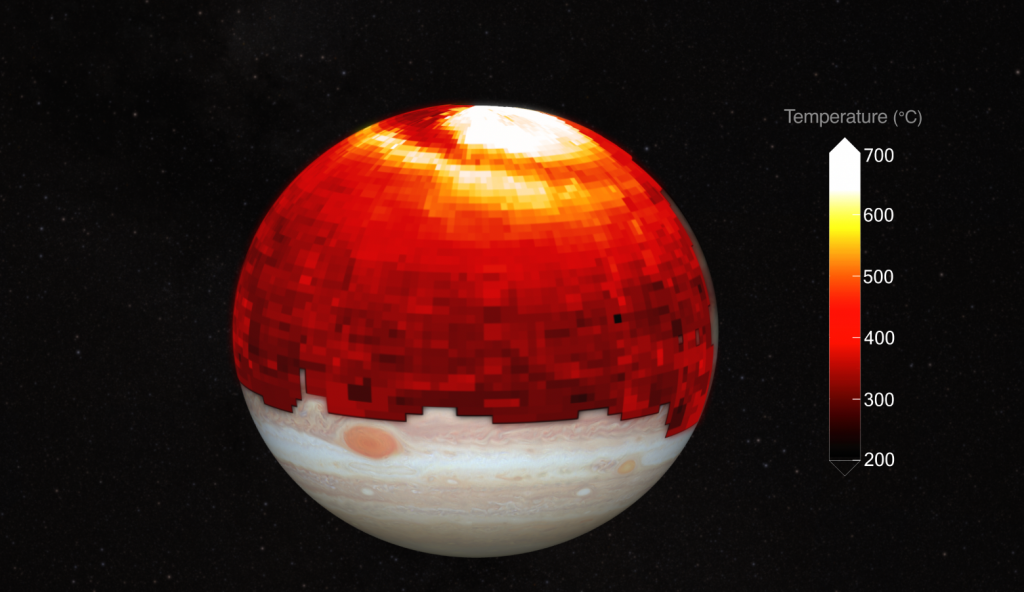Planetary-scale ‘heat wave’ discovered in Jupiter’s atmosphere
Europlanet Science Congress (EPSC) 2022 Press Release
An unexpected ‘heat wave’ of 700 degrees Celsius, extending 130,000 kilometres (10 Earth diameters) in Jupiter’s atmosphere, has been discovered. James O’Donoghue, of the Japanese Aerospace Exploration Agency (JAXA), has presented the results this week at the Europlanet Science Congress (EPSC) 2022 in Granada.
Jupiter’s atmosphere, famous for its characteristic multicoloured vortices, is also unexpectedly hot: in fact, it is hundreds of degrees hotter than models predict. Due to its orbital distance millions of kilometres from the Sun, the giant planet receives under 4% of the amount of sunlight compared to Earth, and its upper atmosphere should theoretically be a frigid -70 degrees Celsius. Instead, its cloud tops are measured everywhere at over 400 degrees Celsius.
“Last year we produced – and presented at EPSC2021 – the first maps of Jupiter’s upper atmosphere capable of identifying the dominant heat sources,” said Dr O’Donoghue. “Thanks to these maps, we demonstrated that Jupiter’s auroras were a possible mechanism that could explain these temperatures.”
Just like the Earth, Jupiter experiences auroras around its poles as an effect of the solar wind. However, while Earth’s auroras are transient and only occur when solar activity is intense, auroras at Jupiter are permanent and have a variable intensity. The powerful auroras can heat the region around the poles to over 700 degrees Celsius, and global winds can redistribute the heat globally around Jupiter.
Looking more deeply through their data, Dr O’Donoghue and his team discovered the spectacular ‘heat wave’ just below the northern aurora, and found that it was travelling towards the equator at a speed of thousands of kilometres per hour.
The heat wave was probably triggered by a pulse of enhanced solar wind plasma impacting Jupiter’s magnetic field, which boosted auroral heating and forced hot gases to expand and spill out towards the equator.
“While the auroras continuously deliver heat to the rest of the planet, these heat wave ‘events’ represent an additional, significant energy source,” added Dr O’Donoghue. “These findings add to our knowledge of Jupiter’s upper-atmospheric weather and climate, and are a great help in trying to solve the ‘energy crisis’ problem that plagues research into the giant planets.”
Images and videos
A panning-view of Jupiter’s upper atmospheric temperatures, 1000 kilometers above the cloud tops. Jupiter is shown on top of a visible image for context. In this snapshot, the auroral region (near the northern pole, in yellow/white) appears to have shed a massive, planetary-scale wave of heating towards the equator. The feature is over 130,000 kilometers long, or 10-Earth diameters, and is hundreds of degrees warmer than the background. Visible Jupiter image is from Hubble / NASA / ESA / A. Simon (NASA GSFC) / J. Schmidt. Credit: James O’Donoghue

Further information
O’Donoghue, J., Moore, L., Bhakyapaibul, T., Johnson, R., Melin, H., and Stallard, T.: A planetary-scale heat wave in Jupiter’s mid-latitude upper atmosphere, Europlanet Science Congress 2022, Granada, Spain, 18–23 Sep 2022, EPSC2022-373, 2022.
https://meetingorganizer.copernicus.org/EPSC2022/EPSC2022-373.html
Science contacts
James O’Donoghue
Institute of Space and Astronautical Science
Japan Aerospace Exploration Agency
jameso@ac.jaxa.jp
Web: https://jamesodonoghue.wixsite.com/home
Twitter: @physicsJ
MEDIA CONTACTS
EPSC2022 Press Office
+44 7756 034243
epsc-press@europlanet-society.org
FURTHER INFORMATION
About the Europlanet Science Congress (EPSC)
The Europlanet Science Congress (https://www.epsc2022.eu/) formerly the European Planetary Science Congress, is the annual meeting of the Europlanet Society. With a track record of 16 years, and regularly attracting around 1000 participants, EPSC is the largest planetary science meeting in Europe. It covers the entire range of planetary sciences with an extensive mix of talks, workshops and poster sessions, as well as providing a unique space for networking and exchanges of experiences.
Follow on Twitter via @europlanetmedia and using the hashtag #EPSC2022.
Details of media briefings and recordings can be found at: https://www.europlanet-society.org/press-briefings-at-epsc2022/
All Europlanet media releases can be found at: https://www.europlanet-society.org/press/
About Europlanet
Since 2005, Europlanet (www.europlanet-society.org) has provided Europe’s planetary science community with a platform to exchange ideas and personnel, share research tools, data and facilities, define key science goals for the future, and engage stakeholders, policy makers and European citizens with planetary science.
The Europlanet 2024 Research Infrastructure (RI) has received funding from the European Union’s Horizon 2020 research and innovation programme under grant agreement No 871149 to provide access to state-of-the-art research facilities and a mechanism to coordinate Europe’s planetary science community.
The Europlanet Society promotes the advancement of European planetary science and related fields for the benefit of the community and is open to individual and organisational members. The Europlanet Society is the parent organisation of the Europlanet Science Congress (EPSC).
About EANA
The European Astrobiology Network Association (http://www.eana-net.eu), joins together people interested in the origins of life and the search for extraterrestrial life in the Solar System and beyond. This interdisciplinary domain involves scientists from multiple disciplines such as chemistry, physics, biology, geology, astronomy, and human sciences.

